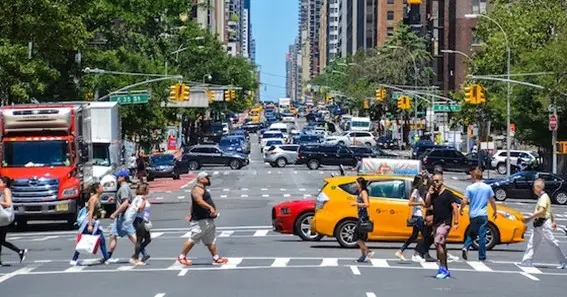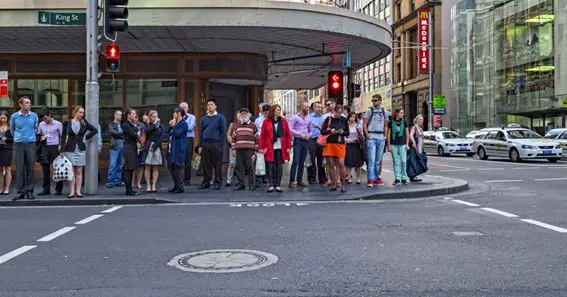What is jaywalking? Jaywalking is crossing a road and violating traffic laws. People commonly call crossing the street without a crosswalk “jaywalking”. Even though it happens regularly, it is illegal and harmful; many individuals do it without knowing the hazards. Jaywalking causes many automobile accidents and deaths; thus, following pedestrian safety standards is crucial.
What Is Jaywalking?
Jaywalking is when a person walks in or crosses a highway without following the rules of the road. Further examples are going past a red light or strolling into traffic without stopping. Jaywalking may appear minor but dramatically increases the risk of car-pedestrian collisions. Traffic accidents kill 5,000 pedestrians annually, according to the NHTSA.
Even though pedestrians aren’t always at blame, crossing without a signal increases automobile accidents. People jaywalk for several reasons, including finding distant crosswalks difficult, not knowing the regulations, or being in a hurry. Jaywalking is illegal and can result in penalties and citations. Now you know what is jaywalking?
Also Read N: What Are SZ Games Github.Io? Discover SZ Games Github.Io
How Can Urban Planning Help Reduce Jaywalking Incidents?

Jaywalking is risky because you cross the roadway without a sidewalk or against the light. It’s usually illegal and can result in penalties or citations. Intelligent urban planning, public education, and technology can reduce jaywalking. Knowing and following pedestrian regulations is crucial.
Legal Implications
Jaywalking involves crossing the roadway without a crosswalk or marking. It also violates traffic signals. Jaywalking is unlawful in most states and punishable by penalties or citations. Knowing what it signifies and what will happen helps pedestrians avoid breaching the law. State sanctions vary, but most entail fines that increase for repeat crimes. Some places penalize repeat offenders with court or community service.
Jaywalking Safety Risks
Jaywalking poses serious safety dangers. When pedestrians cross the street unexpectedly, vehicles may not have time to respond, causing fatal collisions. Jaywalkers are unpredictable, so drivers may swerve or stop to avoid hitting them. This increases vehicle and pedestrian accidents at night or around corners; traffic and poor visibility raise risk. Since there are no designated crossings, cars don’t know when people will cross, making the situation more complicated.
Number Of Pedestrian Accidents
The NHTSA reports that almost 5,000 pedestrians die in vehicle collisions each year, many of them jaywalking. These data emphasize the need to use crosswalks and obey traffic rules to reduce pedestrian fatalities and injuries. Deaths and thousands of catastrophic injuries will have long-term physical, emotional, and financial impacts. This emphasizes the importance of diligent public safety compliance. Keep reading to know more about what is jaywalking.
Also Read P: What Is FYE Slang? Exploring The Meaning Of FYE In Text
Can Urban Planning Alone Solve The Issue Of Jaywalking?

This article discusses what is jaywalking and the comprehensive strategy needed to address pedestrian safety. A comprehensive effort to reduce urban jaywalking includes infrastructure improvements, awareness programs, and tech solutions.
City Planning Changes
Urban planning is crucial to reducing jaywalking. Well-planned cities with enough crosswalks, traffic signs, and walking-friendly infrastructure may significantly reduce jaywalking. Locating and displaying crosswalks might encourage their use. Walking islands, overpasses, and underpasses can aid urban designers in crossing safety. The addition of speed bumps and narrower roadways can help delay vehicle traffic.
Awareness Campaigns
Teaching people that jaywalking is harmful and that crosswalks are vital can affect their conduct. Raising people’s understanding of the hazards and legal repercussions of jaywalking can help make people safer. To reach a large number of people, these campaigns might employ various media, such as social media, public service announcements, posters, and neighbourhood activities. Getting individuals in the region engaged in making these efforts may also help ensure that the teachings stay and encourage people to modify how they act.
Laws And Penalties
Police issue penalties and citations for jaywalking. More police in high-traffic areas can reduce jaywalking. Fines and court appearances are typical penalties in most states. Cities with plenty of foot traffic benefit from targeted policing. Police can monitor busy crossings during rush hours and ticket/warn anyone who crosses without looking. This raises awareness of traffic laws and prevents illegal crossings.
Tech-Based Solutions
New technology like pedestrian recognition and smart traffic signals makes walking safer. Using these technologies in busy areas helps reduce jaywalking crashes. Smart crosswalks that alert drivers to pedestrians are also beneficial. Mobile applications and digital platforms may provide real-time pedestrian safety information, including the optimum routes and stop locations, encouraging safer roadway crossings.
Conclusion
The above blog is all about What is jaywalking. Jaywalking may appear harmless but may cause significant issues and legal repercussions. Unmarked street crossings are risky, and almost 5,000 individuals are killed annually. Understand why people jaywalk, improve city planning, and raise awareness to reduce it. Following traffic laws and using crosswalks may improve roads for everyone. Walkers and drivers must be attentive and prioritize safety to avoid deadly traffic incidents.
FAQ
What Are The Legal Consequences Of Jaywalking?
Jaywalking is unlawful in most states and punishable by penalties or citations. While state penalties vary, they generally involve fines and court appearances. Pedestrians must know these legal implications to keep safe and avoid breaching the law.
Why Is Jaywalking Dangerous?
Jaywalkers cross the street without looking, which might surprise drivers and slow them down. Drivers may not be ready for walkers to suddenly arrive outside crosswalks, causing them to halt or swerve and cause more collisions.
How Can City Planning Reduce Jaywalking?
Urban design may reduce jaywalking by providing adequate crosswalks, pedestrian signs, and other walking-friendly infrastructure. Walking paths and other traffic-calming measures can help improve safety. Jaywalking is less prevalent in well-planned cities that prioritize safety and movement.
How Can Individuals Learn About Jaywalking?
Public awareness campaigns may teach walkers how hazardous jaywalking is and how crucial crosswalks are. These activities may reach many individuals and promote safer walking practices utilizing social media, PSAs, and neighbourhood events. Engaging locals can ensure that the messages are practical and affect behaviour.
Can Technology Prevent Jaywalking Crashes?
Smart crosswalks, automated traffic signals, and pedestrian recognition technologies can make walking safer. This technology can alert drivers to jaywalkers, reducing accidents. Real-time mobile applications that indicate walking pathways and crosswalks can also improve traffic safety.
In Cites How Can Jaywalk Be Avoided?
Options like Walking Island, Overpasses, underpasses and speed bumps can help reduce jaywalks.
Sources:
https://www.trafficsafetystore.com/blog/what-is-jaywalking-and-is-it-really-illegal










